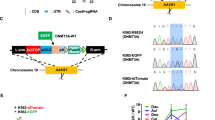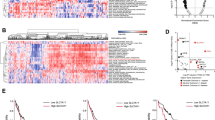Abstract
Acute myeloid leukemia (AML) patients with DNA methyltransferase 3A (DNMT3A) mutation display poor prognosis, and targeted therapy is not available currently. Our previous study identified increased expression of Exportin1 (XPO1) in DNMT3AR882H AML patients. Therefore, we further investigated the therapeutic effect of XPO1 inhibition on DNMT3AR882H AML. Three types of DNMT3AR882H AML cell lines were generated, and XPO1 was significantly upregulated in all DNMT3AR882H cells compared with the wild-type (WT) cells. The XPO1 inhibitor selinexor displayed higher potential in the inhibition of proliferation, promotion of apoptosis, and blockage of the cell cycle in DNMT3AR882H cells than WT cells. Selinexor also significantly inhibited the proliferation of subcutaneous tumors in DNMT3AR882H AML model mice. Primary cells with DNMT3A mutations were more sensitive to selinexor in chemotherapy-naive AML patients. RNA sequencing of selinexor treated AML cells revealed that the majority of metabolic pathways were downregulated after selinexor treatment, with the most significant change in the glutathione metabolic pathway. Glutathione inhibitor L-Buthionine-(S, R)-sulfoximine (BSO) significantly enhanced the apoptosis-inducing effect of selinexor in DNMT3AWT/DNMT3AR882H AML cells. In conclusion, our work reveals that selinexor displays anti-leukemia efficacy against DNMT3AR882H AML via downregulating glutathione pathway. Combination of selinexor and BSO provides novel therapeutic strategy for AML treatment.





Similar content being viewed by others
Data availability
This study provides all raw data free of charge. If you have any questions, please contact xiaoyacai6231@163.com. The RNA-seq raw data of cell lines to the GSA database( https://ngdc.cncb.ac.cn/gsub/ ), and the assigned accession of the submission is HRA005049.
References
Shallis RM, Wang R, Davidoff A et al (2019) Epidemiology of acute myeloid leukemia: Recent progress and enduring challenges. Blood Rev 36:70–87. https://doi.org/10.1016/j.blre.2019.04.005
Shimony S, Stahl M, Stone RM (2023) Acute myeloid leukemia: 2023 update on diagnosis, risk-stratification, and management. Am J Hematol 98(3):502–526. https://doi.org/10.1002/ajh.26822
Lyko F (2018) The DNA methyltransferase family: a versatile toolkit for epigenetic regulation. Nat Rev Genet 19(2):81–92. https://doi.org/10.1038/nrg.2017.80
Khrabrova DA, Yakubovskaya MG, Gromova ES (2021) AML-Associated Mutations in DNA Methyltransferase DNMT3A. Biochemistry. Biokhimiia 86(3):307–318. https://doi.org/10.1134/s000629792103007x
Wakita S, Marumo A, Morita K et al (2023) Mutational analysis of DNMT3A improves the prognostic stratification of patients with acute myeloid leukemia. Cancer Sci. https://doi.org/10.1111/cas.15720
Tazi Y, Arango-Ossa JE, Zhou Y et al (2022) Unified classification and risk-stratification in Acute Myeloid Leukemia. Nat Commun 13(1):4622. https://doi.org/10.1038/s41467-022-32103-8
Balasubramanian SK, Azmi AS, Maciejewski J (2022) Selective inhibition of nuclear export: a promising approach in the shifting treatment paradigms for hematological neoplasms. Leukemia 36(3):601–612. https://doi.org/10.1038/s41375-021-01483-z
Kojima K, Kornblau SM, Ruvolo V et al (2013) Prognostic impact and targeting of CRM1 in acute myeloid leukemia. Blood 121(20):4166–4174. https://doi.org/10.1182/blood-2012-08-447581
Martínez Sánchez MP, Megías-Vericat JE, Rodríguez-Veiga R et al (2021) A phase I trial of selinexor plus FLAG-Ida for the treatment of refractory/relapsed adult acute myeloid leukemia patients. Ann Hematol 100(6):1497–1508. https://doi.org/10.1007/s00277-021-04542-8
Beyan C (2021) Mean platelet volume may not be a predictive and prognostic marker in patients with acute myeloid leukemia. Leuk Lymphoma 62(13):3313. https://doi.org/10.1080/10428194.2021.1953017
Sanmiguel JM, Eudy E, Loberg MA et al (2022) Cell origin-dependent cooperativity of mutant Dnmt3a and Npm1 in clonal hematopoiesis and myeloid malignancy. Blood Adv 6(12):3666–3677. https://doi.org/10.1182/bloodadvances.2022006968
Roca-Portoles A, Rodriguez-Blanco G, Sumpton D et al (2020) Venetoclax causes metabolic reprogramming independent of BCL-2 inhibition. Cell Death Dis 11(8):616. https://doi.org/10.1038/s41419-020-02867-2
Zavorka Thomas ME, Lu X, Talebi Z et al (2021) Gilteritinib Inhibits Glutamine Uptake and Utilization in FLT3-ITD-Positive AML. Mol Cancer Ther 20(11):2207–2217. https://doi.org/10.1158/1535-7163.Mct-21-0071
Yang L, Liu Y, Zhang N et al (2017) Novel impact of the DNMT3A R882H mutation on GSH metabolism in a K562 cell model established by TALENs. Oncotarget 8(18):30395–30409. https://doi.org/10.18632/oncotarget.16449
Kulkoyluoglu-Cotul E, Smith BP, Wrobel K et al (2019) Combined Targeting of Estrogen Receptor Alpha and XPO1 Prevent Akt Activation, Remodel Metabolic Pathways and Induce Autophagy to Overcome Tamoxifen Resistance. Cancers 11(4). https://doi.org/10.3390/cancers11040479
Que Y, Li H, Lin L et al (2021) Study on the Immune Escape Mechanism of Acute Myeloid Leukemia With DNMT3A Mutation. Front Immunol 12:653030. https://doi.org/10.3389/fimmu.2021.653030
Mussai F, de Santo C, Abu-Dayyeh I et al (2013) Acute myeloid leukemia creates an arginase-dependent immunosuppressive microenvironment. Blood 122(5):749–758. https://doi.org/10.1182/blood-2013-01-480129
Weldy CS, Luttrell IP, White CC et al (2012) Glutathione (GSH) and the GSH synthesis gene Gclm modulate vascular reactivity in mice. Free Radic Biol Med 53(6):1264–1278. https://doi.org/10.1016/j.freeradbiomed.2012.07.006
Yang Y, Lin J, Guo S et al (2020) RRM2 protects against ferroptosis and is a tumor biomarker for liver cancer. Cancer Cell Int 20(1):587. https://doi.org/10.1186/s12935-020-01689-8
He Z, Wang S, Shao Y et al (2019) Ras Downstream Effector GGCT Alleviates Oncogenic Stress. iScience 19:256–266. https://doi.org/10.1016/j.isci.2019.07.036
Moreno-Sánchez R, Gallardo-Pérez JC, Rodríguez-Enríquez S et al (2017) Control of the NADPH supply for oxidative stress handling in cancer cells. Free Radic Biol Med 112:149–161. https://doi.org/10.1016/j.freeradbiomed.2017.07.018
Shearn CT, Fritz KS, Shearn AH et al (2016) Deletion of GSTA4-4 results in increased mitochondrial post-translational modification of proteins by reactive aldehydes following chronic ethanol consumption in mice. Redox Biol 7:68–77. https://doi.org/10.1016/j.redox.2015.11.013
Xu X, Wang L, Zang Q et al (2021) Rewiring of purine metabolism in response to acidosis stress in glioma stem cells. Cell Death Dis 12(3):277. https://doi.org/10.1038/s41419-021-03543-9
Dodson M, Darley-Usmar V, Zhang J (2013) Cellular metabolic and autophagic pathways: traffic control by redox signaling. Free Radic Biol Med 63:207–221. https://doi.org/10.1016/j.freeradbiomed.2013.05.014
Liao M, Chen R, Yang Y et al (2022) Aging-elevated inflammation promotes DNMT3A R878H-driven clonal hematopoiesis. Acta Pharm Sin B 12(2):678–691. https://doi.org/10.1016/j.apsb.2021.09.015
Lu R, Wang J, Ren Z et al (2019) A Model System for Studying the DNMT3A Hotspot Mutation (DNMT3A(R882)) Demonstrates a Causal Relationship between Its Dominant-Negative Effect and Leukemogenesis. Cancer Res 79(14):3583–3594. https://doi.org/10.1158/0008-5472.Can-18-3275
Daver N, Schlenk RF, Russell NH et al (2019) Targeting FLT3 mutations in AML: review of current knowledge and evidence. Leukemia 33(2):299–312. https://doi.org/10.1038/s41375-018-0357-9
Sakakibara K, Saito N, Sato T et al (2011) CBS9106 is a novel reversible oral CRM1 inhibitor with CRM1 degrading activity. Blood 118(14):3922–3931. https://doi.org/10.1182/blood-2011-01-333138
Yu H, Wu S, Liu S et al (2022) Venetoclax enhances DNA damage induced by XPO1 inhibitors: A novel mechanism underlying the synergistic antileukaemic effect in acute myeloid leukaemia. J Cell Mol Med 26(9):2646–2657. https://doi.org/10.1111/jcmm.17274
Ranganathan P, Kashyap T, Yu X et al (2016) XPO1 Inhibition using Selinexor Synergizes with Chemotherapy in Acute Myeloid Leukemia by Targeting DNA Repair and Restoring Topoisomerase IIα to the Nucleus. Clinical cancer research : an official journal of the American Association for. Cancer Res 22(24):6142–6152. https://doi.org/10.1158/1078-0432.Ccr-15-2885
Kashyap T, Argueta C, Unger T et al (2018) Selinexor reduces the expression of DNA damage repair proteins and sensitizes cancer cells to DNA damaging agents. Oncotarget 9(56):30773–30786. https://doi.org/10.18632/oncotarget.25637
Jeong M, Park HJ, Celik H et al (2018) Loss of Dnmt3a Immortalizes Hematopoietic Stem Cells In Vivo. Cell Rep 23(1):1–10. https://doi.org/10.1016/j.celrep.2018.03.025
Glass JL, Hassane D, Wouters BJ et al (2017) Epigenetic Identity in AML Depends on Disruption of Nonpromoter Regulatory Elements and Is Affected by Antagonistic Effects of Mutations in Epigenetic Modifiers. Cancer Discov 7(8):868–883. https://doi.org/10.1158/2159-8290.Cd-16-1032
Venugopal K, Feng Y, Nowialis P et al (2022) DNMT3A Harboring Leukemia-Associated Mutations Directs Sensitivity to DNA Damage at Replication Forks. Clinical cancer research : an official journal of the American Association for. Cancer Res 28(4):756–769. https://doi.org/10.1158/1078-0432.Ccr-21-2863
Qu Y, Lennartsson A, Gaidzik VI et al (2014) Differential methylation in CN-AML preferentially targets non-CGI regions and is dictated by DNMT3A mutational status and associated with predominant hypomethylation of HOX genes. Epigenetics 9(8):1108–1119. https://doi.org/10.4161/epi.29315
Ferreira HJ, Heyn H, Vizoso M et al (2016) DNMT3A mutations mediate the epigenetic reactivation of the leukemogenic factor MEIS1 in acute myeloid leukemia. Oncogene 35(23):3079–3082. https://doi.org/10.1038/onc.2015.359
Martínez-Reyes I, Chandel NS (2021) Cancer metabolism: looking forward. Nat Rev Cancer 21(10):669–680. https://doi.org/10.1038/s41568-021-00378-6
Sharma H (2018) Development of Novel Therapeutics Targeting Isocitrate Dehydrogenase Mutations in Cancer. Curr Top Med Chem 18(6):505–524. https://doi.org/10.2174/1568026618666180518091144
Subedi A, Liu Q, Ayyathan DM et al (2021) Nicotinamide phosphoribosyltransferase inhibitors selectively induce apoptosis of AML stem cells by disrupting lipid homeostasis. Cell Stem Cell 28(10):1851–67.e8. https://doi.org/10.1016/j.stem.2021.06.004
Pei S, Minhajuddin M, Callahan KP et al (2013) Targeting aberrant glutathione metabolism to eradicate human acute myelogenous leukemia cells. J Biol Chem 288(47):33542–33558. https://doi.org/10.1074/jbc.M113.511170
Yu XA, Lu M, Luo Y et al (2020) A cancer-specific activatable theranostic nanodrug for enhanced therapeutic efficacy via amplification of oxidative stress. Theranostics 10(1):371–383. https://doi.org/10.7150/thno.39412
Cheng X, Xu HD, Ran HH et al (2021) Glutathione-Depleting Nanomedicines for Synergistic Cancer Therapy. ACS Nano 15(5):8039–8068. https://doi.org/10.1021/acsnano.1c00498
Habermann KJ, Grünewald L, Van Wijk S et al (2017) Targeting redox homeostasis in rhabdomyosarcoma cells: GSH-depleting agents enhance auranofin-induced cell death. Cell Death Dis 8(10):e3067. https://doi.org/10.1038/cddis.2017.412
Tanaka Y, Komatsu T, Shigemi H et al (2014) BIMEL is a key effector molecule in oxidative stress-mediated apoptosis in acute myeloid leukemia cells when combined with arsenic trioxide and buthionine sulfoximine. BMC Cancer 14:27. https://doi.org/10.1186/1471-2407-14-27
Schoeneberger H, Belz K, Schenk B et al (2015) Impairment of antioxidant defense via glutathione depletion sensitizes acute lymphoblastic leukemia cells for Smac mimetic-induced cell death. Oncogene 34(31):4032–4043. https://doi.org/10.1038/onc.2014.338
Acknowledgments
The National Natural Science Foundation of China [82270177] and Hubei Chen Xiaoping science and Technology Development Foundation [CXPJJH12000009-112].
Institutional review board
The study was conducted by the Declaration of Helsinki, and approved by the Ethics Committee of Tongji Hospital, Tongji Medical College, Huazhong University of Science and Technology (TJIRB20230228 and 2023.2.10). The animal study protocol was approved by the Ethics Committee of Tongji Medical College, Huazhong University of Science and Technology ([2022]IACUC Number: 3300 and 2022.2.1).
Funding
This work was supported by the National Natural Science Foundation of China [82270177] and Hubei Chen Xiaoping Science and Technology Development Foundation [CXPJJH12000009-112].
Author information
Authors and Affiliations
Contributions
XC, DL and XW conceptualized this study. XC completed data curation. YL, HL, and XW con-ducted the investigation. XC, DL, YL, YQ, and XW completed the methodology. DL was re-sponsible for project administration. MX and YW were in charge of the software. XC wrote the original draft. DL wrote, reviewed, and edited the manuscript. All authors contributed to the ar-ticle and approved the submitted version.
Corresponding authors
Ethics declarations
Informed consent
Informed consent was obtained from all subjects involved in the study. Written informed consent has been obtained from the patient(s) to publish this paper.
Conflicts of interest
The authors declare that the research was conducted in the absence of any commercial or financial relationships that could be construed as a potential conflict of interest.
Additional information
Publisher’s Note
Springer Nature remains neutral with regard to jurisdictional claims in published maps and institutional affiliations.
Rights and permissions
Springer Nature or its licensor (e.g. a society or other partner) holds exclusive rights to this article under a publishing agreement with the author(s) or other rightsholder(s); author self-archiving of the accepted manuscript version of this article is solely governed by the terms of such publishing agreement and applicable law.
About this article
Cite this article
Cai, X., Liu, Y., Li, H. et al. XPO1 inhibition displays anti-leukemia efficacy against DNMT3A-mutant acute myeloid leukemia via downregulating glutathione pathway. Ann Hematol (2024). https://doi.org/10.1007/s00277-024-05706-y
Received:
Accepted:
Published:
DOI: https://doi.org/10.1007/s00277-024-05706-y




